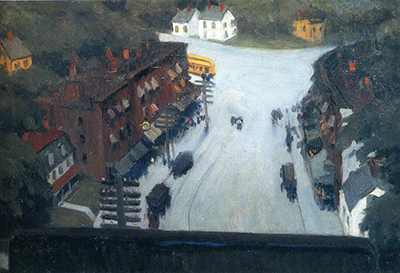When many people think of Edward Hopper, their mind likely conjures up images of interior scenes largely devoid of human activity; solitary figures conveying loneliness in various locations, such as gas stations, restaurants, and movie theatres.
However, Hopper's extensive body of work also includes a large number of landscapes, cityscapes, and street scenes.
This painting, American Village, was painted by Edward Hopper in 1912, more than a decade before he broke through to become one of the most well-known artists in America.
It was during this same year that Hopper, seeking new imagery and inspiration, travelled outside of his native New York to Massachusetts and began work on his first outdoor paintings of America.
In American Village, the view is from an overpass above a main village street.
The colours are muted and somewhat blurred. The buildings, mostly rendered in darker shades of brown all have awnings hanging over their store fronts, obscuring the view of the shop windows and the shoppers themselves.
Only a few bright images break up the hazy scene: a bright yellow street car as it turns off of the street, a yellow house to the left, behind the row of shops, and the white house at the end of the street.
It was during this time, at the beginning of the century, that Edward Hopper was truly beginning to find his own distinct style and artistic voice with his paintings.
The influence of French masters such as Édouard Manet and Edgar Degas is apparent in his work at this time. However, even at this early phase in his artistic career, with paintings such as American Village, it is clear that he was already adept at using light and colour to create a quiet yet dramatic rendering of his own personal vision of American life.




